

| history page | home page |
The BSA’s First Eagle Scout
Arthur Rose Eldred
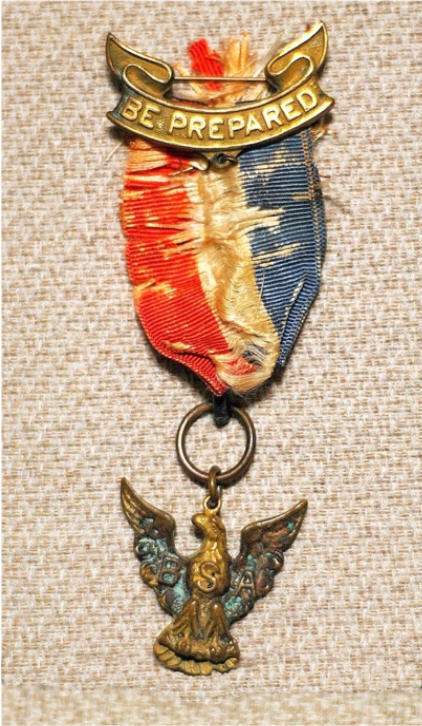
Arthur Eldred’s Eagle Medal
Courtesy National Scouting Museum
There have been several articles written about the Boy Scouts of America’s first
Eagle Scout, Arthur Rose Eldred. Many of these seem to draw on an unknown common
source or sources. For this reason certain erroneous information has been
perpetuated: for example that Eldred had a local board of review (then called
court of honor) for his Eagle before having his National Court of Honor (board
of review); and a widely published but misattributed photograph showing an early
Eagle Scout, and identified as Arthur Eldred.
It is in the interest of correcting such errors, and presenting additional facts
to the history surrounding the BSA’s first Eagle Scout that I will attempt to
lay down certain established facts based on primary sources whenever possible.
My interest in the subject first began when I purchased two original photographs
of an early Boy Scout with 21 merit badges on his uniform sleeve, and medals on
his chest. Printed in ink on the bottom of one of the photographs was “Arthur
Rose Eldred”. Needless to say, I recognized the name, and was eager to discover
if this indeed was the BSA’s first Eagle Scout. Like so many others, I had seen
a photograph in the 1985 book The Boys Scouts: An American Adventure, and again
in an article in the “Scouting” magazine purported to be Arthur Eldred. There
was not much resemblance to the photographs in my possession. I, therefore,
contacted the National Scouting Museum, and asked if they had any other pictures
of Eldred. They were able to supply only one picture of Eldred as an adult, at
the Eagle Scout award ceremony for his son, Willard, on October 27, 1944. In
return, I sent copies of my two photographs to the museum. Although considerably
older in the picture, I could see a strong resemblance between the adult Arthur
and the two photographs I had. However, I was still not able to reconcile the
photographs with the one appearing in the publications. Unable to get any more
information, I set them aside until one day, while researching another topic on
the internet, I happened to see a copy of a letter to the editor of “Scouting”
from Willard Eldred stating that the photograph shown in these publications was
not of his father, but rather Theodore Gaty Jr., the 38th Eagle Scout badge
which was announced in the August 1913 issue of “Boy’s Life”.
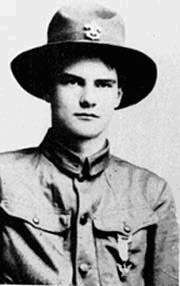
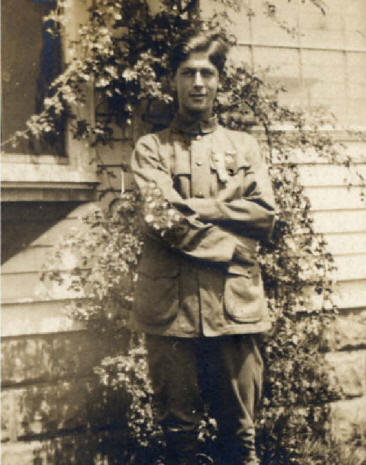
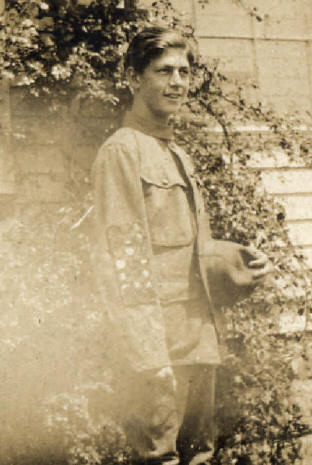
Authentic pictures of Arthur Eldred
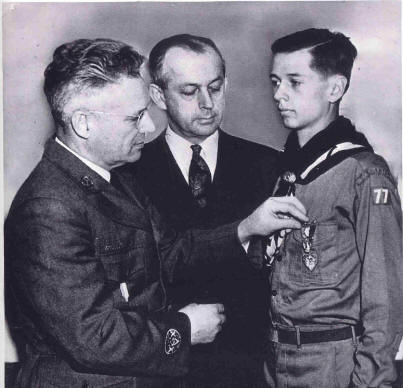
Arthur Eldred (center) with son Willard
I was able to contact Willard Eldred, and quickly solve the
puzzle. Mr. Eldred had one picture of his father as a Scout, and it was
identical to the named picture I had. In addition, he was able to authenticate
the second photograph (obviously taken the same day at the same location, but a
different pose) as being also of his father. He stated he had never seen this
second photograph before. In addition, Mr. Eldred was kind enough to provide me
several documents including: a photocopy of a letter written by his father in
March 1940 to the principal of his old high school in which he discussed his
Scouting career; a copy of his Scoutmaster’s account of their troop serving as
honor guard for the visit of Lord Baden-Powell in 1912 to New York; an account
of Arthur Eldred’s life saving actions which led to his receiving a meritorious
award; and a copy of letter in which James West officially notified Eldred that
he was the first Eagle Scout. From these documents, and other accepted sources
the following facts can be established.
Arthur Rose Eldred was born in Brooklyn, NY on August 16, 1895. His father died
when Arthur was very young, and he was raised in Oceanside, Long Island, NY by
his mother. Scouting came to Oceanside in 1910, largely through the efforts of
Arthur’s older brother, Hubert W. Eldred. There was a troop of American Boy
Scouts (an early rival to the BSA which had as its benefactor William Randolf
Hearst), in nearby Rockville Centre, NY. The methods of the ABS revolved around
military drills, which this troop held in the Rockville Centre Club. Hubert
Eldred went to New York City to the ABS Headquarters to see about forming an ABS
troop in Oceanside. However, during his visit to New York, he also visited
the offices of the fledgling organization of the Boy Scouts of America, which
were then located in the YMCA Headquarters building. Hubert was so impressed
with the ideals of the BSA that he decided to form what was to become BSA Troop
1 of Rockville Centre, NY in November 1910, and served as its Scoutmaster. The
troop was designated by this city name because the Eldred residence was located
on Terrell Ave which was listed as Rockville Centre by the Post Office for
delivery of the mail. However, all the boys in the troop attended the Oceanside
School. This troop was also instrumental in starting the first BSA troop at
nearby Freeport, Long Island, NY.
Troop meetings were held on the second floor of the Eldred barn on Terrell Ave.
Eldred’s troop was one of the first troops in the United States to be completely
uniformed. Each boy had to earn money for his own uniform. So important was this
to the boys, that one young Scout, Melvin Daly who Arthur later saved from
drowning, once came to a Scout meeting in heavy snow in shoes with soles worn to
the skin in order to save money for his Scout pants.
Being so well uniformed and drilled, it was only logical that James E. West, the
first National Scout Executive, asked the Scoutmaster to bring the two local
troops to New York City to serve as honor guard for General Robert S. Baden
Powell. “BP”, the founder of the Boy Scout movement, was due to arrive in New
York from England on January 31, 1912 to begin a multi-city lecture tour. The
Scoutmaster gave his regrets, but told West that his troop did not have the
carfare for the 21 mile train trip. However, the Scout Executive immediately
said that if the troops would come all expenses would be paid by his office.
The Scoutmaster related in his report that General Baden Powell said: “that his
finest memory of his entire trip around the world, was sailing up beautiful New
York Harbor, and seeing the long line of erect uniformed Boy Scouts with the
American flag on the right of the line and the British Cross of St. Andrew on
the left of the line and the Boy Scout Flag in the center”.
As General Baden Powell walked down the gang plank of the SS Arcadian, forty Boy
Scouts moved to form two long lines on each side facing inward. BP stopped to
ask each Scout his name and rank. Arthur Eldred, being the tallest of the Scouts
at 16 years old was the last Scout in line. The Scoutmaster stated that BP’s
face lit up when he saw the many merit badges on Eldred’s sleeve and his large
gold colored First Class pin. He grabbed Arthur’s hand and asked him all about
his merit badges. Arthur was extremely modest by nature, so much so that in
future life he rarely if ever spoke about himself or his achievements. His face
turned red in embarrassment as BP continued to address him while the adult
welcoming committee could only stand and wait.
In his letter to the Principal of Oceanside Senior High School, Arthur also
stated that at the first rally held by the Boy Scouts of America in New York (at
the 71st Regiment Armory in February 1911) Eldred’s troop put on a “most
spectacular” demonstration in lashing a 20 foot signal tower of saplings and
then continued with a signaling exhibition. As a result of this display of Scout
skills, the troop was invited to visit a number of troops in New York City and
Westchester County to discuss their troop activities.
One source outside of the documents I have states that Arthur earned his first
class badge in March, 1911. Like many of the first few Eagle Scouts, Eldred did
not receive either a Life or Star Badge (Life proceeded Star until 1922), but
went straight to Eagle. At this time, First Class was considered the highest
rank in Scouting, but Scouts could be “Merit Scouts” by earning the required
merit badges to become a Life Scout, Star Scout and an Eagle Scout. In the early
days of the BSA, these awards might be likened more to super merit badges rather
than ranks.
Eldred completed the required 21 merit badges for Eagle in April of 1912.
In the August 1912 issue of Boy’s Life, Eldred was listed in the Honor Roll
section as having received the following merit badges: Civics, Cooking, Cycling,
Electricity, Firemanship, First Aid to Animals, Gardening, Handicraft,
Horsemanship, Interpreting of French, Life Saving, Painting, Pathfinding,
Personal Health, Poultry Farming, Public Health, Swimming, Chemistry, Dairying,
Business, and Plumbing.
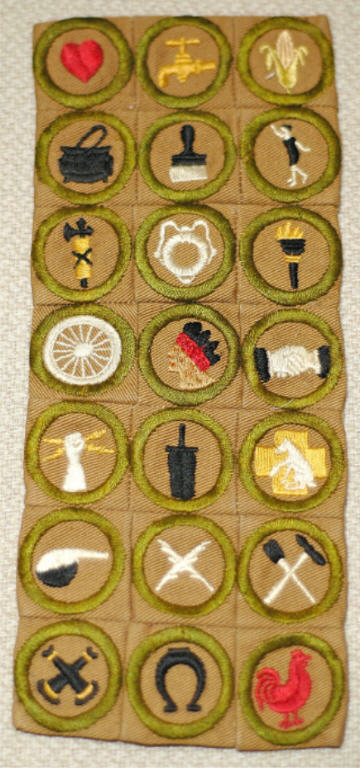
Arthur Eldred’s Merit Badges
Courtesy National Scouting Museum
In his
letter to his principal, Eldred states that he “of course” did not have a local
court of honor (board of review) but secured affidavits from the local men who
examined him for his merit badges. He did, however, have to undergo a board of
review by members of the National Staff of the BSA to see if he was properly
qualified. Eldred stated that Daniel Carter Beard, the first National Scout
Commissioner, examined him personally on several subjects. Wilbert E.
Longfellow, who had written articles on life-saving and swimming in the Scout
Manual, examined him on those subjects. James West and others also “grilled” him
rather thoroughly. Other sources state that Ernest Thompson Seton, First Chief
Scout, also examined Arthur.
In a letter dated
August 21, 1912, James E. West formally notified Arthur Eldred that he had the
honor of being the first Eagle Scout of the Boy Scouts of America. In this
letter, West informed him that the Eagle badge would be presented at a later
date. A primary reason for this was that the dies for the badge had not yet been
made. Eldred received the actual badge on Labor Day 1912.
In August of 1912, Arthur Eldred was to qualify for a second exceptional award.
While on a camping trip with the troop to Orange Lake, NY a non-swimmer 15 year
old Scout, Melvin Daly, waded out into the lake and found himself in water over
his head. He started to drown. Arthur Eldred, seeing the Scout’s predicament,
swam out and pulled Melvin up from the bottom. Daly grabbed Eldred in a “death
grip”, and a struggle began. Another Scout, Merritt Cutler, swam out to help.
Daly then grabbed him, and they both went under. Eldred then was able to bring
Daly to shore, and went back to assist Cutler. Two other Scouts in the troop
witnessed the rescue, and signed statements in an application for the life
saving award. It has been said that Arthur was presented the BSA Honor Medal by
Chief Seton. In the photographs in my possession, this award can be seen on
Arthur’s uniform.
Eldred was a student at Oceanside School and was first to receive the Regent’s
Certificate after it was approved as a high school. He entered Cornell
University in the fall of 1912 to study agriculture.
As for Rockville Centre BSA Troop 1, most of the Scouts in the troop were also
17 of 18 years old by the time Arthur received his Eagle Medal. In the early
part of 1913, the troop more or less disbanded, and Arthur’s brother Hubert left
Rockville Centre about the same time.
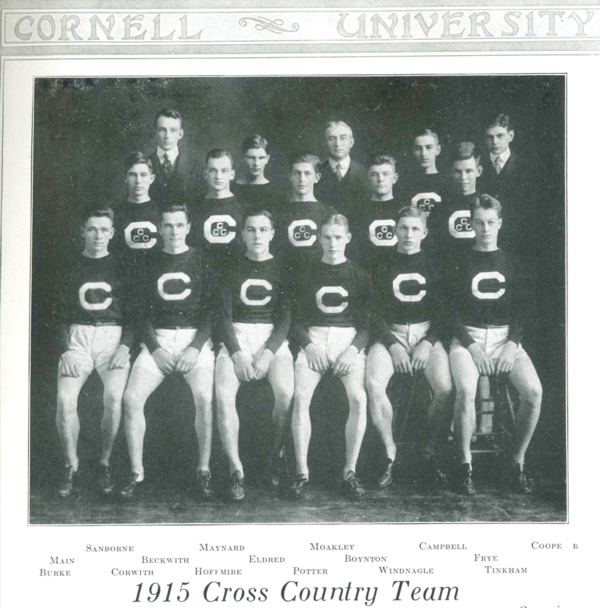
Arthur Eldred is in the center of this photo of the 1915 cross country team

1916 Cornell graduation photo
A 1985 article of “Scout Memorabilia” gives the following information about
Eldred’s later life. At the university, Arthur was on the track and
cross-country teams, and president of the Cornell University Agricultural
Association. He graduated in 1916. During World War I, he served as an enlisted
man aboard a U.S. Navy submarine chaser based in Corfu Greece. Upon his return
to the United States Eldred went to work for a dairy, and in 1921 became the
agricultural agent for Atlantic County in New Jersey. During the seven years in
that position, Eldred was credited with establishing the Atlantic City municipal
market for farm products, as well as other accomplishments on behalf of the
county’s farmers.
In 1928, Eldred left his county job to become a specialist in promoting railroad
transportation of produce for the Reading Railroad. As movement of produce by
truck became an ever more important part of transportation, Arthur was named
manager of the Motor Carrier Committee of the Eastern Railroad Association. He
held this position until his death on January 4, 1951.
Throughout his life, Eldred continued his interest in Scouting. In the 1920’s he
was a board of review examiner. He also was Troop Committee Chair for his son’s
Troop 77 in Clementon, NJ, and served as a member of Camden County Council. He
also served on the Clementon Board of Education, and was president of the
Overbrook regional school board.
Gary Twite
District Commissioner
Green River District
Chief Seattle Council BSA
February 2005
(Gary received the following e-mail in March 2005 from Willard Eldred, Arthur Eldred's son, in response to a request to proofread the above biography)
Gary,
Thanks for sending me the very comprehensive article on my father. I could not detect any errors based on what I know. You are correct in assuming that the Scoutmaster [from a document called Scoutmaster’s report] was my father’s older brother who was - as I recall - some 12 to 14 years older. I only met Uncle Hubert on 2 occasions as he lived in Maine, Mexico and Arkansas.
All the best to you and your scouting friends,
Bill
Last update: 11/15/2009